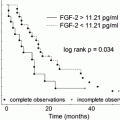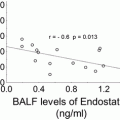© Springer International Publishing Switzerland 2014
Mieczyslaw Pokorski (ed.)Lung Cancer and Autoimmune DisordersAdvances in Experimental Medicine and Biology83310.1007/5584_2014_17The Potential of Wharton’s Jelly Derived Mesenchymal Stem Cells in Treating Patients with Cystic Fibrosis
(1)
Polish Stem Cell Bank, 2/41 Grzybowska St., 00-131 Warsaw, Poland
(2)
Department of Laboratory Diagnostics and Clinical Immunology, Medical University of Warsaw, Warsaw, Poland
(3)
Department of Pediatric Hematology and Oncology, Medical University of Warsaw, Warsaw, Poland
Abstract
Cystic fibrosis (CF) is a life-threatening autosomal recessive multi-organ disorder with the mean incidence of 0.737 per 10,000 people worldwide. Despite many advances in therapy, patients fail to have a satisfactory quality of life. The end-stage lung disease still accounts for significant mortality and puts patients in the need of lung transplantation. Even though the disease is monogenic, the trials of topical gene transfer into airway epithelial cells have so far been disappointing. It is proven that stem cells can be differentiated into type II alveolar epithelial cells. Wharton’s jelly-derived mesenchymal stem cells (MSC) from non-CF carrier third-party donors could be an effective alternative to bone marrow or embryonic stem cells. The harvesting process is an easy and ethically uncontroversial procedure. The MSC cell should be applied through repetitive infusions due to rapid lung epithelial cell turnover. However, the low stem cell incorporation remains a problem. Pre-clinical studies imply that even 6–10 % of the wild-type cystic fibrosis transmembrane conductance regulator (CFTR) expression could be enough to restore chloride secretion. The route of administration, the optimal dose, as well as the intervals between infusions have yet to be determined. This review discusses the clinical potential of mesenchymal stem cell in CF patients.
Keywords
Cystic fibrosisLung diseasesStem cell therapyUmbilical cord1 Introduction
Cystic fibrosis (CF) is a fatal monogenetic autosomal recessive disease that involves pathology of exocrine gland function and results in multi-organ complications, with pulmonary involvement in most cases and end-stage lung disease as a major cause of death. Due to the advances in patient care, more CF individuals reach adult age; however, they have to cope with long-term consequences including diabetes, bone disease, arthropathy, chronic kidney disease, and depression (Quon and Aitken 2012). Even though survival rates are higher year-by-year and many advances in therapy have been made, lung transplantation often remains the only effective therapeutic approach. Cystic fibrosis is caused by different mutations in cystic fibrosis transmembrane conductance regulator (CFTR) that causes dysfunctional cAMP-mediated chloride transport in exocrine epithelia and deregulated sodium transport. Those pathological changes result in defective mucociliary clearance leading to mucous obstruction, infection, inflammation, and lung scarring (Lubamba et al. 2012). CF, as a monogenic disease, seems to be an ideal candidate for gene therapy. However, intensive pre-clinical experiments have failed to show satisfactory therapeutic outcome due to existing limitations such as the absence of viral vector receptors, the presence of mucus barrier, the rapid cell turnover, the inflammatory response, and the uncertainty of which cell should be chosen as a target. The issue is further confounded by the fact that a single lung stem cell probably does not exist; rather there are several stem cell niches with different cell progenitors depending on the part of the respiratory tract. Moreover, CFTR has been found to be mostly expressed in submucosal glands, not accessible by gene therapy, although likely containing stem cells that could be targeted. Only about 10 % of the stem cell engraftment would be enough to reverse chloride defect; therefore if only chloride transport correction would be enough for symptoms amelioration, a therapeutic effect could be obtained (Spencer and Jaffe 2004).
2 Rationale for Stem Cell Therapy
In recent years, there has been a great interest in stem cell biology and potential therapeutic indications. Several studies have already demonstrated that stem cell therapy could bring benefits in treating patients with pulmonary diseases. An interesting study done by Gilpin et al. (2013) showed increases in the epithelial-like progenitors and differences in plasma cytokines responsible for the cell recruitment in the bone marrow and peripheral blood of CF patients. Those alternations might contribute to the remodeling of the lung architecture seen in cystic fibrosis. The questions concerning whether an increase in the epithelial-like progenitors is a consequence or cause of epithelial hyperproliferation in CF patients and how it might affect stem cell therapy remain to be answered. The stem cells have proved to be capable of differentiating into lung parenchyma and airway epithelial cells both in vitro and in vivo. They have a potential in treatment of chronic lung diseases with their remarkable characteristics to home into damaged tissue and the ability to contribute to organ regeneration (Loebinger et al. 2008). The idea of using hematopoietic stem cells is supported by Suratt et al. (2003) who revealed the donor-derived cells in the lungs of human female patients after hematopoietic stem cell transplantation from male donors. Until then, that phenomenon had been proven only in the murine model. In the Suratt et al.’s (2003) study, diagnostic evaluation of tissue samples was done retrospectively in patients who underwent lung biopsy or autopsy. Fluorescent in situ hybridization showed significant rates of epithelial (8 %) and endothelial (42 %) chimerism. Kleeberger et al. (2003) confirmed these results, detecting chimerism in a short tandem repeat analysis of tissue samples from seven human males, recipients of female lung allograft. The recipient-derived cells were integrated in the bronchial epithelium (5.7–25.5 %), type II pneumocytes (9.1–20.0 %), and seromucosal glands (9.1–24.2 %) with higher rates in the structures with signs of chronic injury. The exact mechanism of cell incorporation remains unknown and could have to do with cell trans-differentiation, paracrine effects, cell fusion, β-catein signaling pathways, or membrane-derived microvesicles (Wang et al. 2009). A limitation of stem cell therapy in CF may be the abnormalities of immune cells that can be found in these patients. Their neutrophils are unable to cope with bacterial infections, especially with Pseudomonas aeruginosa. The patients’ inflammatory response is normal, with influx of neutrophils in the airways. However, CF patients secrete less L-selectin and more myeloperoxidase and elastase in comparison with healthy subjects. Conese et al. (2003) suggest that neutrophilic abnormalities might open possibilities of hematopoietic stem cell as a target for therapy. The CFTR is expressed by neutrophilic phagolysosomes; therefore its function could be defective as the loss of chloride secretion impairs the hypochlorous acid production which contributes to bacterial killing (Painter et al. 2006). Some authors claim that genetic factors might cause other neutrophilic dysfunctions as well. Stem cell engraftment into the CF lungs could limit bacterial infection and excessive inflammatory response.
3 Therapeutic Approaches
3.1 Stem Cell Types
The biology of progenitor cells in the lung is complicated and has not yet been fully understood. Science has not determined which type of cells could bring the highest benefit to the patient. A better understanding of the biology of lung injury/repair and the mechanisms involved in lung diseases is needed as well. Studies confirmed that hematopoietic stem cells can convert into the lung cells (Alliota et al. 2005; Surrat et al. 2003); however, they do not seem to carry a regenerative potential. Endothelial stem cells, multipotent adult progenitor cells, induced pluripotent stem cells, mesenchymal stem cells, or circulating fibrocytes are in the area of intensive research. Mesenchymal cells, non-hematopoietic stem cells with the fibroblast-like appearance, with their biological characteristics including the ability to home into inured tissues and proliferation and differentiation potential, seem to be interesting candidates for further studies. Moreover, mesenchymal cells, with a low degree of immunogenicity, are ideal candidates for the allogeneic use (Caimi et al. 2010). Additionally, they possess immunomodulatory and anti-inflammatory properties that could contribute to CF therapy by reducing susceptibility to infections.
3.2 Source Selection
Several therapeutic approaches and different stem cell sources are considered for stem cell therapy. Bone marrow cells are most often used and frequently examined. Loi et al. (2006) hypothesized whether adult bone marrow stem cell with wild-type CFTR could result in functional CFTR expression in a mice model of CF. The engraftment rate was very low at 0.025 %; CFTR expression was detected only in 0.01 % of engrafted cells. The authors also conducted the same experiment with CD3-depleted total marrow cells, but the donor-derived epithelial stem cells were not detected. Bruscia et al. (2006) checked the same hypothesis. CFTR activity was measured in the gastrointestinal and pulmonary tracts by rectal and nasal sample analysis in transplanted mice. CFTR mRNA expression and a modest level of CFTR-dependent chloride secretion could be detected in the examined samples.
The number of studies concerning the adipose tissue-derived stem cells in human lung diseases is limited. The potential of these cells has not been examined in animal models of CF. Suzuki et al. (2008) showed that these cells accelerate neovascularization and epithelialization of regenerated trachea placed in a bioengineered scaffold.
Embryo-derived stem cells originate from a blastocyst embryo stage and can differentiate spontaneously into tissues of all germ layers. The ability of murine embryonic stem cells to differentiate into type II alveolar epithelial cells, nonciliated secretory epithelial airway cells, and type I collagen has already been demonstrated. Coraux et al. (2005) showed that air-liquid interface-cultured embryo-derived stem cells can form fully differentiated and functional airway epithelium. Leblond et al. (2009) also confirmed the effectiveness of this source; however, still with low engraftment rates. Although the embryo-derived stem cells have high differentiation capabilities, a comprehensive view is rather unpromising. The donation process is ethically controversial and this source of stem cells has the highest tumorigenic potential, so that the perspective of clinical application is low.
Stay updated, free articles. Join our Telegram channel

Full access? Get Clinical Tree





